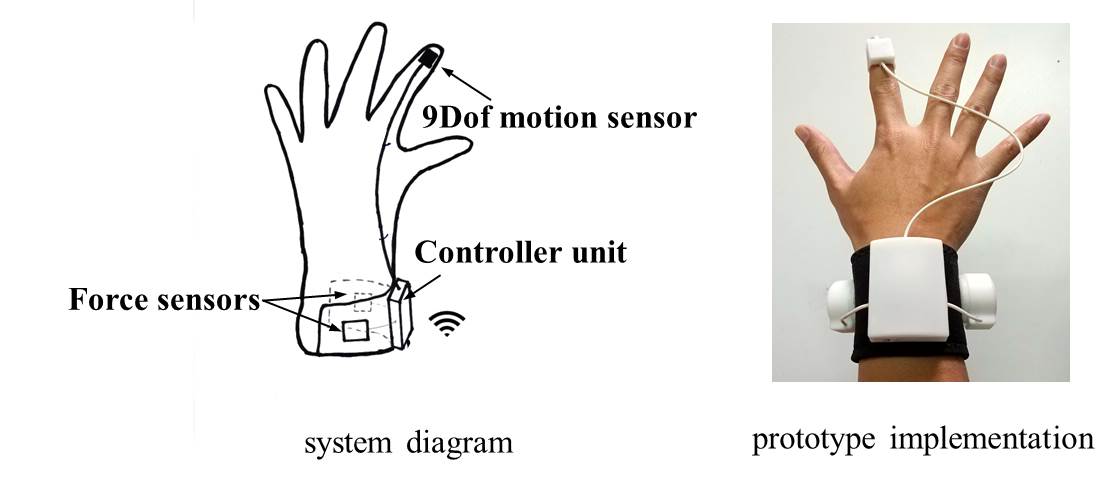Session Information
Date: Sunday, October 7, 2018
Session Title: Technology
Session Time: 1:45pm-3:15pm
Location: Hall 3FG
Objective: The objective of this study was to evaluate the feasibility of a wrist-worn wearable device to assist with the quantitative assessment of hand motor symptom, involving tremor, bradykinesia, and rigidity, in patients with PD.
Background: Currently, the clinical evaluation of PD mainly relies on the MDS-UPDRS, which is affected by the subjective judgment and clinical experience of the evaluators. Objective quantification of hand motor symptoms in PD based on wearable motion sensor technology has been the subject of several studies. However, most of the previous studies unable to measure all hand motor symptoms in a single assessment system.
Methods: In this study, a custom wrist-worn wearable device (Fig. 1) based on the nine degrees-of-freedom (9DoF) motion sensors and force sensors was proposed to capture the hand movement information during the clinical assessment tasks. Rapid hand opening/closing, tremor during rest, postural and kinetic task, and wrist rigidity movements were measured with the proposed quantification system. The multivariable regression model was used to involve quantitative tremor parameters to output quantitative tremor scores, and the multi-class support vector machine (SVM) classifier was employed to estimate the bradykinesia severity. In describing the severity of rigidity, the mechanical impedance model was applied to find an optimal quantitative evaluation index.
Results: Clinical experiments with 20 PD patients and 10 age-matched healthy controls showed that the predicted tremor scores correlated well with the clinical assessment results (r2=0.95), and the proposed method can correctly distinguish the bradykinesia severity with superior classification accuracy (93.3%). The mechanical impedance correlated well with the clinical rigidity scores (Pearson correlation coefficient r=0.872), and it can be used as an optimal quantitative evaluation index to describe the rigidity severity.
Conclusions: The methodology described and the results presented in this study demonstrated the applicability of quantifying hand motor symptoms in PD patients with a single wearable system. Smart clothes and insoles based on motion sensors are developing and full motor assessment of the whole body of PD patients will be carried out in the near future.
References: [1] Guoen Cai, Zhirong Lin, Houde Dai, et al. Quantitative assessment of parkinsonian tremor based on a linear acceleration extraction algorithm. Biomedical Signal Processing and Control, vol. 42, pp. 53-62, April 2018 [2] Zhirong Lin, Houde Dai, Yongsheng Xiong, et al. Quantification assessment of bradykine-sia in Parkinson’s disease based on a wearable device. In 39th Annual International Con-ference of the IEEE Engineering in Medicine and Biology Society (EMBC’17), Seogwipo, South Korea, July 2017, pp. 803-806
To cite this abstract in AMA style:
Q. Ye, Z. Lin, H. Dai, Y. Xiong, G. Cai. Quantitative assessment of the hand motor symptoms in Parkinson’s disease based on a custom wearable device: A Proof-of-Principle Study [abstract]. Mov Disord. 2018; 33 (suppl 2). https://www.mdsabstracts.org/abstract/quantitative-assessment-of-the-hand-motor-symptoms-in-parkinsons-disease-based-on-a-custom-wearable-device-a-proof-of-principle-study/. Accessed December 18, 2025.« Back to 2018 International Congress
MDS Abstracts - https://www.mdsabstracts.org/abstract/quantitative-assessment-of-the-hand-motor-symptoms-in-parkinsons-disease-based-on-a-custom-wearable-device-a-proof-of-principle-study/

